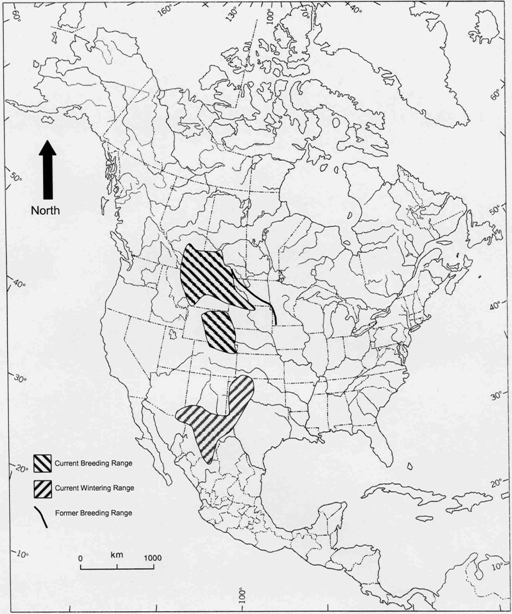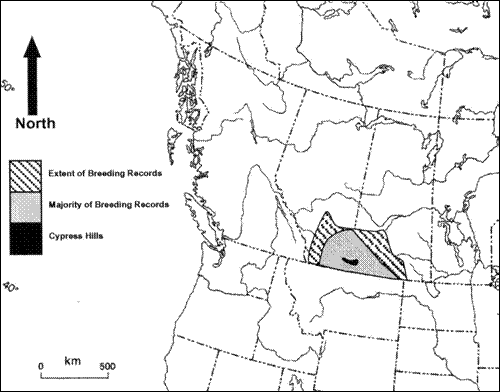McCown's longspur (Calcarius mccownii) COSEWIC assessment and status report: chapter 4
Distribution
Global range
McCown's Longspurs breed from southeastern Alberta and southwestern Saskatchewan, south through Montana, central and eastern Wyoming, and northcentral Colorado (With 1994a, Smith 1996, Dechant et al. 1999; Figure 1). There are also breeding populations in western Nebraska, southwestern North Dakota, and northcentral South Dakota (Dechant et al. 1999). Breeding populations tend to be disjunct throughout the range (Kantrud and Kologski 1982). The wintering range in the southwestern United States and northwestern Mexico includes western Oklahoma, western Kansas, western Texas, southeastern Arizona, southern New Mexico, northern Sonora, Chihuahua, and northern Durango. Occasional winter records include California, Utah, Nevada, and southeastern Colorado (With 1994a).
The breeding range has contracted substantially during the 20th century and McCown's Longspurs are extirpated from western Minnesota (last record in 1900). Although Taverner (1927 in With 1994a) listed McCown's Longspurs as formerly breeding in Manitoba, it is unlikely that this is the case (Carey 2003, K. de Smet, pers. comm.).
Figure 1. Breeding and wintering range of the McCown's Longspur (based on Peterson and Chalif 1973, Semenchuk 1992, With 1994a, Smith 1996, AOU 1998, Saskatchewan Wetland Conservation Corporation 2002, National Audubon Society 2003, Sauer et al. 2004).

Canadian range
Canada encompasses an estimated 34% of the McCown's Longspur's North American breeding range (P. Blancher, pers. comm.). In Alberta, breeding records extend as far north as Hanna and Youngstown and as far west as Drumheller, Vulcan, and Lethbridge. The majority of breeding records, however, are in southeastern Alberta, south of the Red Deer River and east of Brooks (Semenchuk 1992, Alberta Conservation Association and Alberta Environment 2004; Figure 2). The breeding range in southern Alberta is restricted to the Grassland Natural Region. McCown's Longspurs are absent from Writing-on-Stone Provincial Park and the high elevations of Cypress Hills Interprovincial Park. In Saskatchewan, McCown's Longspurs are restricted to the Prairie Ecozone. Breeding records extend from the southwestern corner of the province north to Saskatoon and east to Regina (Smith 1996, Saskatchewan Conservation Data Centre 2004; Figure 2); however, the majority are in southwestern Saskatchewan (south of the South Saskatchwan River and west of Regina; Smith 1996, Saskatchewan Conservation Data Centre 2004; Figure 2). The species is uncommon at the edge of its breeding range on the southern edge of the Parkland (Smith 1996). Thus, possible breeding records near Saskatoon should probably be considered outliers (S. Davis, pers. comm.).
The extent of occurrence (EO) for the McCown's Longspur based on digitized range maps is approximately 212,000 km² (P. Blancher, pers. comm.). The area of occupancy (AO) is 67,000 km² and is based on the area of remaining native grassland. This estimate is likely an overestimate of the AO for this species, however, because not all native grassland is suitable habitat for McCown's Longspur (see below).
Figure 2. Breeding range of the McCown's Longspur in Canada (based on Semenchuk 1992, With 1994a, Smith 1996, AOU 1998, Saskatchewan Wetland Conservation Corporation 2002, National Audubon Society 2003, Sauer et al. 2004). Longspurs are uncommon on the edge of their breeding range (diagonal stripes) and are absent from the high elevations of Cypress Hills (black).
